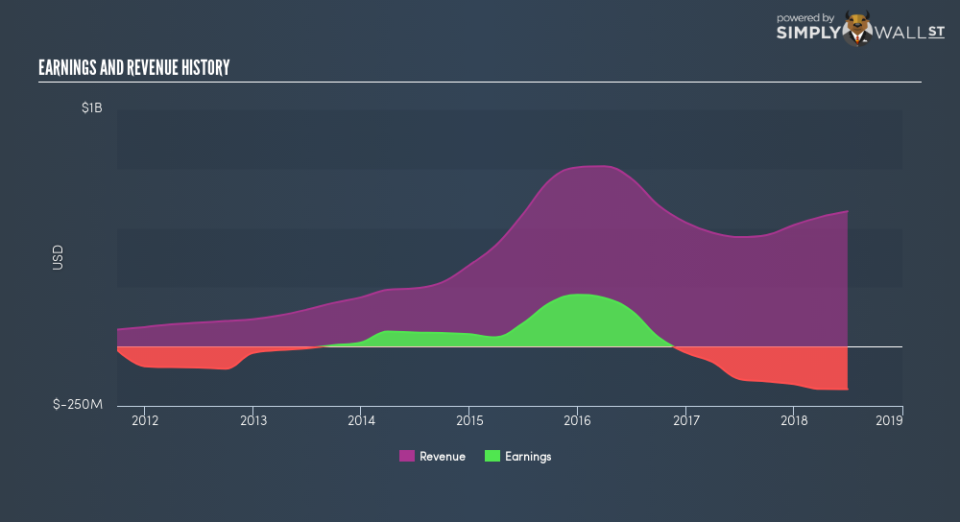What Are The Drivers Of Scorpio Tankers Inc’s (NYSE:STNG) Risks?

If you are a shareholder in Scorpio Tankers Inc’s (NYSE:STNG), or are thinking about investing in the company, knowing how it contributes to the risk and reward profile of your portfolio is important. STNG is exposed to market-wide risk, which arises from investing in the stock market. This risk reflects changes in economic and political factors that affects all stocks, and is measured by its beta. Not all stocks are expose to the same level of market risk, and the broad market index represents a beta value of one. Any stock with a beta of greater than one is considered more volatile than the market, and those with a beta less than one is generally less volatile.
See our latest analysis for Scorpio Tankers
An interpretation of STNG’s beta
Scorpio Tankers has a beta of 1.11, which means that its stock price experiences greater change than most. Based on this beta value, STNG will help diversify your portfolio, if it currently comprises of low-beta stocks. This will be beneficial for portfolio returns, in particular, when current market sentiment is positive.
Could STNG’s size and industry cause it to be more volatile?
With a market cap of US$716.32m, STNG falls within the small-cap spectrum of stocks, which are found to experience higher relative risk compared to larger companies. In addition to size, STNG also operates in the oil and gas industry, which has commonly demonstrated strong reactions to market-wide shocks. As a result, we should expect higher beta for small-cap stocks in a cyclical industry compared to larger stocks in a defensive industry. This supports our interpretation of STNG’s beta value discussed above. Fundamental factors can also drive the cyclicality of the stock, which we will take a look at next.
Can STNG’s asset-composition point to a higher beta?
During times of economic downturn, low demand may cause companies to readjust production of their goods and services. It is more difficult for companies to lower their cost, if the majority of these costs are generated by fixed assets. Therefore, this is a type of risk which is associated with higher beta. I test STNG’s ratio of fixed assets to total assets in order to determine how high the risk is associated with this type of constraint. STNG’s fixed assets to total assets ratio of higher than 30% shows that the company uses up a big chunk of its capital on assets that are hard to scale up or down in short notice. Thus, we can expect STNG to be more volatile in the face of market movements, relative to its peers of similar size but with a lower proportion of fixed assets on their books. This is consistent with is current beta value which also indicates high volatility.
What this means for you:
You may reap the gains of STNG’s returns in times of an economic boom. Though the business does have higher fixed cost than what is considered safe, during times of growth, consumer demand may be high enough to not warrant immediate concerns. However, during a downturn, a more defensive stock can cushion the impact of this risk. In order to fully understand whether STNG is a good investment for you, we also need to consider important company-specific fundamentals such as Scorpio Tankers’s financial health and performance track record. I urge you to complete your research by taking a look at the following:
Future Outlook: What are well-informed industry analysts predicting for STNG’s future growth? Take a look at our free research report of analyst consensus for STNG’s outlook.
Past Track Record: Has STNG been consistently performing well irrespective of the ups and downs in the market? Go into more detail in the past performance analysis and take a look at the free visual representations of STNG’s historicals for more clarity.
Other High-Performing Stocks: Are there other stocks that provide better prospects with proven track records? Explore our free list of these great stocks here.
To help readers see past the short term volatility of the financial market, we aim to bring you a long-term focused research analysis purely driven by fundamental data. Note that our analysis does not factor in the latest price-sensitive company announcements.
The author is an independent contributor and at the time of publication had no position in the stocks mentioned. For errors that warrant correction please contact the editor at editorial-team@simplywallst.com.

 Yahoo Movies
Yahoo Movies 

